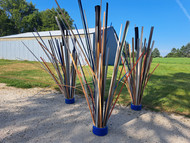How to Properly Care For Freshwater Fish in Artificial Habitats
Posted by Fish Hiding on 13th Sep 2024
Creating large outdoor artificial fish habitats can be a rewarding experience for enthusiasts looking to replicate a natural aquatic environment. These fish habitats offer plenty of space for freshwater fish to thrive. However, maintaining a healthy underwater habitat requires proper planning, consistent care, and regular monitoring to ensure a balanced ecosystem. Here's how to properly care for freshwater fish in large natural outdoor artificial fish habitats.
Design the Habitat Carefully
The first step in creating successful large outdoor artificial fish habitats is planning the design. The size and depth will depend on the species and number of fish you intend to keep. For most freshwater fish, a minimum depth of 3 to 4 feet is recommended to maintain a stable temperature and protect against predators. Incorporate cover into varying depths, such as shallow areas and deeper zones, to mimic the most natural environment, which will allow fish to explore and hide.
Manage Algae Growth and Aquatic Plants
Outdoor artificial fish habitats are prone to algae growth due to sunlight exposure. While some algae can be beneficial, excessive growth can deplete oxygen and block sunlight, harming fish and plants. Introduce aquatic plants like water lilies, hornwort, and duckweed to balance the ecosystem and provide natural shade. These plants help control algae and offer hiding spots and breeding grounds for fish. Additionally, consider adding algae-eating fish or snails to help manage algae naturally.
Feed Fish Appropriately and Avoid Overfeeding
Proper feeding is vital for fish health in artificial habitats. Different species have varying dietary needs, so research the appropriate diet for your fish. Forage fish like fathead minnows, perch and panfish are best foods for predator fish. Overfeeding is common in outdoor habitats when utilizing store bought pellets and feeds. Uneaten food can quickly decompose and pollute the water, so a natural approach and moderation prevail here as well..
Regular Maintenance and Monitoring
Consistent maintenance is key to the success of outdoor artificial fish habitats. Regularly clean the excess muck, leaves or debris. Check for leaks, damage, or signs of predators. Observe the fish daily for any signs of disease, stress, or unusual behavior, which could indicate water quality issues or other problems.
By following these guidelines, you can create a thriving outdoor artificial fish habitat that closely mimics a natural ecosystem. Proper care and maintenance will ensure your freshwater fish remain healthy and vibrant, bringing life and beauty to your outdoor space. Be sure to reach out to Fishiding Artificial Fish Habitats today for consultation on all the best attractors and habitat on the market!



